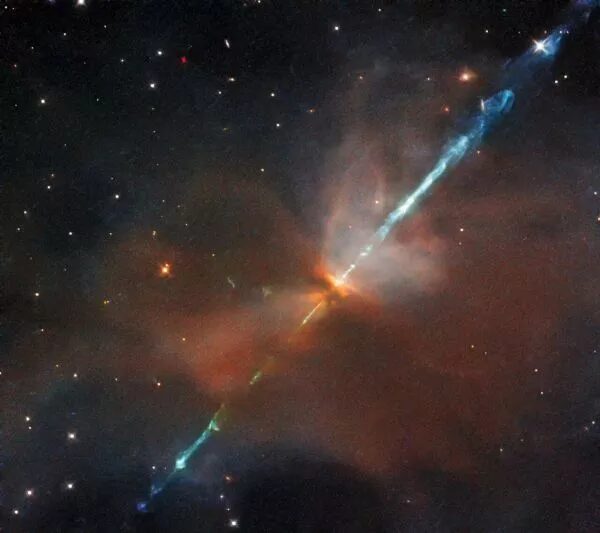
The "sword" is composed of twin jets of superheated, ionized gas that are rocketing into space from opposite poles of a newborn star called IRAS 05491+0247. The "heart" is the cloud of leftover dust and gas surrounding the protostar, according to Hubble team members.
This dramatic interaction between jets and cloud creates an uncommon celestial sight known as a Herbig-Haro object. The one photographed here by Hubble is named HH111, and it lies about 1,300 light-years from Earth, in the constellation Orion.
Hubble captured the image using its Wide Field Camera 3 (WFC3) instrument, which observes in both optical and infrared (heat) wavelengths of light.
"Herbig-Haro objects actually release a lot of light at optical wavelengths, but they are difficult to observe because their surrounding dust and gas absorb much of the visible light," European Space Agency (ESA) officials wrote in a description of the image, which was released Monday (Aug. 30).
"Therefore, the WFC3's ability to observe at infrared wavelengths — where observations are not as affected by gas and dust — is crucial to observing [Herbig]-Haro objects successfully," they added.
Hubble, a joint mission of NASA and ESA, launched to low Earth orbit aboard the space shuttle Discovery in April 1990. The first images the iconic observatory captured were fuzzy, a problem that team members soon determined was caused by a flaw in Hubble's 7.9-foot-wide (2.4 meters) primary mirror.
Spacewalking astronauts fixed that issue in December 1993, and Hubble was further upgraded and maintained over the course of four more servicing missions. The WFC3 instrument was installed during the last of these Hubble-bound space shuttle flights, which took place in May 2009.
Hubble continues to provide amazing views of the cosmos, but it has begun to show its age, and, without the shuttle, astronauts can no longer feasibly access the observatory. (It's technically possible that a crewed vehicle such as SpaceX's Crew Dragon capsule could reach Hubble, but that idea apparently has not been seriously investigated.) The telescope has overcome a number of glitches recently, including a computer problem that closed its supersharp eye for more than a month this summer.



R.C.